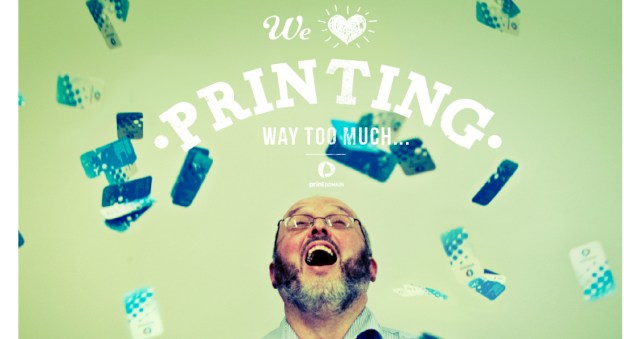
Never mind the old adage that the customer is always right. Some of them are wrong most of the time, and most of them are wrong some of the time – there’s just never a good time to tell them.
Instead, it’s accepted as good form to let them think they’re right. You can do that by offering the kind of service they think they deserve. That, however, can be a trap for printers.
Yes, offering great customer service, not just a cheap price, is the key to profitability (and hence longevity) in printing. But there comes a time when a line has to be drawn to differentiate between excellent customer service and working for nothing.
Every print business has had its share of customers from hell. Every printer can relate a customer service story of woe, and most can find a funny side to it. The others have gone out of business.
For many printers, the nightmare client is a designer. (But creatives also cop the same kind of treatment, if graphic design blog site ‘Clients From Hell’ is anything to go by. Doozies from this website include requests such as “This business card you designed for me is upside down” and “Can you just match it to the blue of the sky?”. See box below for more).
Paul Richardson, managing director of Lindsay Yates Group, describes the customer from hell as “the one who signs off on a proof but they want to do a press check, and they have particular PMS colours in mind and four-colour process, but when it comes down to the press they decide to change the colours. Years ago, you used to be able to wear that, but these days you just can’t afford to.”
Theo Pettaras, managing director of Digitalpress in Sydney’s Surry Hills, points to some distinct characteristics of the bad customer. “I think every printer has a few of them. The typical client from hell generally is very disorganised, has false expectations, is a narcissist, and thinks they know it all. Do I really have to remind myself of the experience? In saying that, we never burn any bridges.”
Damage control
Kerim El Gabailli, managing director at Prografica in Sydney, is comfortable with their client list, and has developed a system to deal with them.
“Luckily, we don’t have many customers from hell, and in the past we slowly moved them on. Now we have learnt to manage the different personalities. Most of the issues we have are minor – for example, ridiculous deadlines or spelling mistakes that are not our fault but rather their designers.
“We have a policy of not discounting anything that is deemed to be our fault but rather reprint the job in full. We do this so that the customer doesn’t get into the bad habit of always looking for faults just so that they can get a discount.”
But what constitutes good service and what is just silly business practice? There are lots of ways a printer can offer a service yet maintain control of the relationship, but many printers find themselves trapped in practices that make profitable operations that much harder.
You don’t need to be reminded that times are tight, and cost structures need to be constantly scrutinised for waste. This applies equally to materials and operational procedures. Doing work for nothing is worse than offering a price that is too cheap, but many printers are prepared to overlook some minor services to maintain a close relationship. That includes fixing corrupt or poorly prepared PDF files or artwork. These chores take time – and time is money – but there is compensation in doing this for some customers, says Cliff Brigstocke, chief executive of Opus Print Group.
“We find some self-publishers require more support than our larger media, advertising or global publishing clients. However, once you share the tricks of the trade, they get it quickly and become loyal customers,” he says.
“In the main, Opus companies do small jobs such as file-fixing for no charge as we are a very service-based organisation.”
Richardson agrees with this sentiment. “There are clients who really don’t understand the process but you try to educate them and you don’t really mind doing that. They take on board what you’re doing – trying to change things for their benefit.
“Within reason, we do small things for no charge. If we need to do it quickly and it’s below a certain threshold then we’ll do it. There is stuff that’s not worthwhile charging for; it’s not really justifiable charging for every little thing. But we do track all authors’ changes, and if it continues we’ll do something about it,” adds Richardson.
“I enjoy trying to educate customers, especially people like young designers. It’s often time well invested. It is a cost to us to do it but we feel that in the long run we’ll have a customer for life.”
Agree to agree
For large clients that expect to track work any under contract, the most effective path is a service-level agreement (SLA), in which all facets of a project can be decided beforehand. SLAs are defined ways of measuring a supplier’s performance. Generally speaking, a service level measures quality, capacity, reliability, timeliness, accuracy and efficiency.
A good SLA can be designed to align the incentives of the printer and customer. As an example, because a fixed price contract provides a printer with an incentive to cut costs (and perhaps quality) to increase margin, the SLA for a fixed price contract should focus on quality and timeliness. Both parties should then benefit.
Brigstocke says Opus uses an SLAs “normally for our larger clients, and certainly for those that are based regionally or internationally. It makes the rules of engagement clear, and as long as they are set in conjunction with the client, should positively drive both organisations’ behaviour.”
Pettaras agrees that SLAs work well, “depending on the client, usually for our large clients like financial institutions and large corporates. The larger advertising agencies like using them as well.”
SLAs bring a return to the printer in the form of accountability, he says. “It’s a great way to keep you on your toes, maintaining operational efficiencies and a constant focus on excelling in customer service.”
Lindsay Yates Group utilises SLAs with some clients, and has found they not just assist in servicing those clients, but add a level of scrutiny to the company’s operations that fine tunes their performance with every customer.
“We use SLAs with several contracted clients, with fairly rigid KPIs. We meet every six months, previewing and review-ing KPIs to see if they’re being achieved, and we’ll rate ourselves on what has happened in the previous six months and see of there are areas we need to pick up in,” says Richardson.
Even with service at a high point, some printers still lose out on operating profitably through neglect of their debtors ledger. Every printer ProPrint has spoken to recently is acutely aware of payment terms being stretched to breaking point. The PIAA has hosted functions in three states with the assistance of HLB Mann Judd, dealing with intractable debt problems. The result of these problems for printers is poor cashflow and loss of financial stability, and even closure.
Steven Michell, an insolvency expert at HLB Mann Judd, and his colleague, Tony Kabrovsky, used the functions to demonstrate solutions to late payment. By reining in debts by just one day, printers can enjoy cash flow benefits. Reducing late debtor payments by a week can provide significant financial benefits. Employing a credit controller may return the cost of their wage and much more.
Richardson says: “The cost of putting on a credit controller can be offset by the benefits of reining in your debtors list. We’ve never got rid of a client because they extended their terms, but we try to work with them, and if they’ve got a problem we try and work with their problem. We’ve been burnt, but we got through, and we’ve become more wary.”
Pettaras has a few tips on how to “politely rein them in”. He points to reverse psychology, “being genuine in your desire to do the best for the client”, and making sure the client knows that its supplier cannot produce the impossible.
Another trap is failing to pass on extra costs, such as consumables price rises, particularly paper. Easier said than done, but with margins wafer thin, those costs will look better on customers’ invoices. Similarly, new efficiencies from better practices and new technology should be harnessed to boost profits rather than lowering prices to be more “competitive”.
Do these small matters make a difference? They can and do. As another old saying goes: “Look after the pennies and the pounds look after themselves”.
clients from hell
Client – “It’s the wrong shade of black.”
Client – “I’m not able to open PDF files: I don’t use a Mac. Luckily, my assistant was able to open your PDF, print it, scan it and save it as a JPG. I have to say, the colours you’ve chosen are horrible.”
Supplier – ”Can you give me a list of printing companies you have a relationship with so I can get an estimate?” Client ”No, sorry. We owe them a bunch of money.”
Client – “Will the final print look more like a matte or glossy finish? Can’t tell from looking at my screen.”
Client – “Could we print the brochure in RGB? You know, it would be cheaper if we use one colour less…”
Client – “We need business cards designed to impress people in big companies… set up in Word so we can print them in our office.”
More at www.clientsfromhell.net
top tips SLAs
· Developing the right SLA starts with asking the right questions.
· Define service levels and how you will measure them before setting performance expectations.
· A good SLA matches the printer’s incentives with the customer’s objectives, and includes service level credits and termination rights.
· It should require the printer to provide clear and timely reports on performance for each period.
· The SLA can include both minimum service levels and target service levels. The printer would be obligated to meet minimum service levels, and failing to do so would be a breach of the contract. The target service levels would be measured, and there might be service level credits associated with failure to meet them, but occasional failures would not usually be a breach of contract
Comment below to have your say on this story.
If you have a news story or tip-off, get in touch at editorial@sprinter.com.au.
Sign up to the Sprinter newsletter

